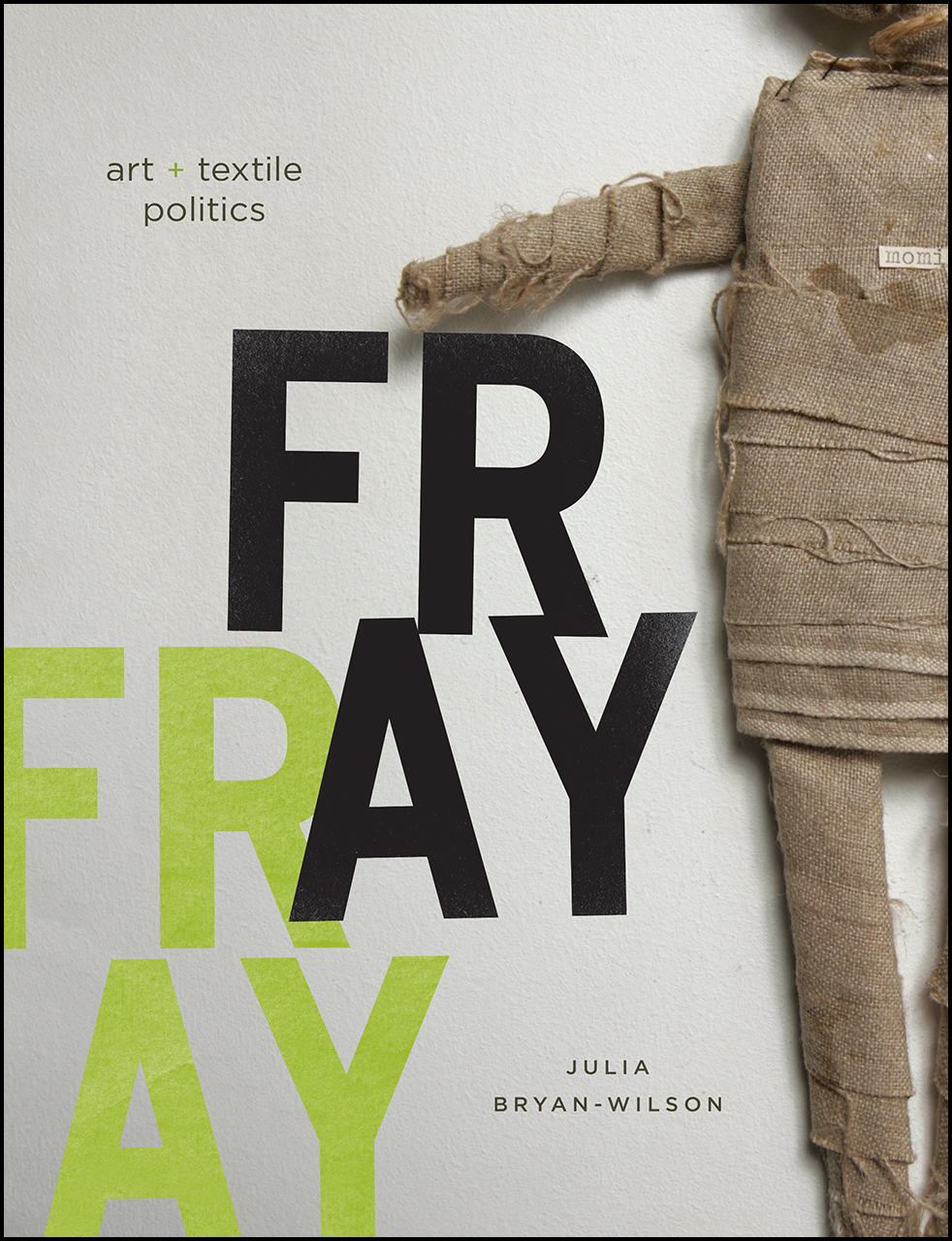Julia Bryan-Wilson: Fray: Art and Textile Politics (2017)
Filed under book | Tags: · activism, aids, art, art criticism, art history, craft, feminism, fiberwork, folk art, gender, handmaking, labour, politics, queer, quilting, race, textile, textile design, weaving

“In 1974, women in a feminist consciousness-raising group in Eugene, Oregon, formed a mock organization called the Ladies Sewing Circle and Terrorist Society. Emblazoning its logo onto t-shirts, the group wryly envisioned female collective textile making as a practice that could upend conventions, threaten state structures, and wreak political havoc. Elaborating on this example as a prehistory to the more recent phenomenon of “craftivism”—the politics and social practices associated with handmaking—Fray explores textiles and their role at the forefront of debates about process, materiality, gender, and race in times of economic upheaval.
Closely examining how amateurs and fine artists in the United States and Chile turned to sewing, braiding, knotting, and quilting amid the rise of global manufacturing, Julia Bryan-Wilson argues that textiles unravel the high/low divide and urges us to think flexibly about what the politics of textiles might be. Her case studies from the 1970s through the 1990s—including the improvised costumes of the theater troupe the Cockettes, the braided rag rugs of US artist Harmony Hammond, the thread-based sculptures of Chilean artist Cecilia Vicuña, the small hand-sewn tapestries depicting Pinochet’s torture, and the NAMES Project AIDS Memorial Quilt—are often taken as evidence of the inherently progressive nature of handcrafted textiles. Fray, however, shows that such methods are recruited to often ambivalent ends, leaving textiles very much “in the fray” of debates about feminized labor, protest cultures, and queer identities; the malleability of cloth and fiber means that textiles can be activated, or stretched, in many ideological directions.
The first contemporary art history book to discuss both fine art and amateur registers of handmaking at such an expansive scale, Fray unveils crucial insights into how textiles inhabit the broad space between artistic and political poles—high and low, untrained and highly skilled, conformist and disobedient, craft and art.”
Publisher University of Chicago Press, 2017
ISBN 9780226077819, 0226077810
326 pages
via slowrotation
Reviews: Holland Cotter (New York Times, 2017), Barbara Wisnoski (J Canadian Art History, 2018), Alexa Griffith Winton (J Design History, 2019), Janis Jefferies (Art Bulletin, 2019), Elizabeth S. Hawley (Winterthur Portfolio, 2019), Jayme Collins (InVisible Culture, 2019), Jason Edwards (Sculpture J, 2019), Katarzyna Falęcka (J Visual Culture, 2021).
Video interview with author (with Lynne Cooke, NGA, 60 min, 2017)
PDF (18 MB)
Comment (0)Wendy Bark: Constructivist Costume, Textile & Theatrical Design, 1917-1934 (1995)
Filed under thesis | Tags: · 1910s, 1920s, 1930s, art history, constructivism, costume design, design, fashion design, textile design, theatre

This thesis follows the life of the art movement known as Constructivism through the turbulent post-revolutionary years, up to the onset of Socialist Realism, a doctrine imposed on the Arts by governmental directives. It focuses on the areas of fashion, textile and theatrical design, which themselves are strongly influenced by extra-artistic factors – economics, sociology and the historical era – as was the ethos of Constructivism.
After a brief introduction giving some background information on the art world and the main artist-designers of the study, the chapters go on to discuss the factors affecting the rise and then the waning popularity of the constructivist ideology, explaining the focal tenets of Constructivism, particularly in relation to fashion, textile and theatrical design. Since the majority of constructivist works were completed during the time span covered by NEP, those chapters relating to NEP have thus been given emphasis. Some biographical details about the main artists of the study are given at the end, and the Glossary lists the most common acronyms and abbreviations used in the text. The illustrations are intended as a companion to the text, since often the artistic effects of designers cannot be described adequately by language alone.
The study focuses on six artist/designers: Vladimir Tatlin, Alexander Rodchenko, Varvara Stepanova, Liubov Popova, Alexandra Exter, and Nadezhda Lamanova.
Full title: Constructivist Costume, Textile & Theatrical Design, 1917-1934: A Study of Constructivism Set in the Socio-cultural, Political and Historical Context of Post-Revolutionary Russia
Masters thesis
Durham University
285 pages

